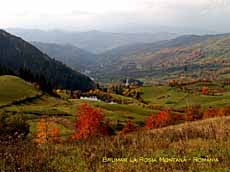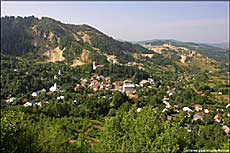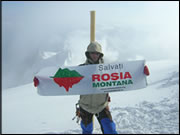|
Rosia Montana, Romania
|

The Rosia Montana valley.
Credit:
Alburnus Maior
| The area
of the proposed Rosia Montana project is located in the Apuseni
mountains of west central Romania. If constructed by Toronto-based
Gabriel Resources, Rosia Montana would become Europe's largest
open-pit gold mine operation. In order for the project to be
economically feasible, the Rosia Montana valley, the oldest
documented settlement in Romania, would be carved into four open-pit
mines. The neighboring valley of Corna would be transformed into an
unlined cyanide storage "pond" covering a surface of up to 600
hectares (1,482 acres), held back by a 180-meter high dam. The pits
would generate roughly 196.4 million tons of cyanide-laced waste.
Local opposition to the mine is based in part on the disastrous
experience at the Baia Mare gold mine in Romania, where a cyanide
spill in 2000 polluted the Tisza and Danube Rivers, contaminating
the drinking water supplies of 2.5 million people and killing 1200
tons of fish. The type of dam proposed in Gabriel Resources'
Feasibility Study could pose high economic and environmental risks
for the company and the country. According to Dr. David Chambers,
geophysicist and Executive Director of Center for Science in Public
Participation, Gabriel Resources' Feasibility Study does not detail
the risks of a landslide or an earthquake in this area, nor does it
describe the standard to which the dam was designed in order to
withstand this risk. If the dam were to fail, toxic mining residues
could be released into the Abrud River near the dam -- potentially
resulting in severe damage similar to the Baia Mare experience.
|

Protest against
proposed open-pit mine.
Credit: Alburnus
Maior
| In order to make
way for this mega-project, more than 2000 people would be
displaced--many of them are subsistence farmers who do not want to
leave their lands--and nearly 900 homes would have to be torn down
in order to make way for the mine project. The mine would employ a
workforce of 250 to 300 people over the mine's estimated lifespan of
15 years, according to the International Finance Corporation (IFC),
the World Bank's private lending arm.
Gabriel Resources, which has no previous mining experience, had
approached the IFC for a loan believed to be approximately $250
million. According to Dundee Securities, a financial securities
firm, Gabriel Resources' founder and chairman Frank Timis had two
convictions for possessing heroin with intent to sell. An earlier
venture of Mr. Timis, a Ukrainian petrol company, had been barred
from the Toronto stock exchange. (Gabriel Resources is currently
listed on the Toronto exchange.)
On October 10, 2002, the IFC announced that it would not
financially support the controversial project. In an official
statement, the IFC "concluded that it is in everybody's best
interest that we do not pursue discussions with the company
regarding IFC's involvement in the project."
|

Rosia Montana valley.
Credit:
Greenpeace
| The project has
also been heavily criticized by a group of 83 economics professors
from Romania's prestigious ASE University as well as by a host of
international archaeologists who are worried about the project's
destructive impact on the area's unique Roman mine galleries and
other archaeological treasures. Church leaders have also spoken out
against the proposal, which would destroy eight churches and nine
cemeteries.
For more information:
Alburnus Maior
http://www.rosiamontana.org/
Images of Rosia Montana, including existing
mining operations:
http://www.eurasischesmagazin.de/info/article.asp?article=20041105
Financial
Times column, Gold is Not
Enough. April
08, 2004.
Comments on the
Rosia Montana Feasibility Study
By Dr. David
Chambers, Center for Science in Public Participation
http://www.rosiamontana.org/documents/pdf/feasibcomment.pdf
|

Campaigner at Mont
Blanc's peak. Credit: Alburnus
Maior
|
Evaluating Risk:
Investors' Guide to Gabriel Resources' Rosia Montana
Proposal
Taking it To the
Top: Alburnus Maior press release
chronicling the climb of Mont Blanc to call attention to the
campaign to save Rosia Montana
|

